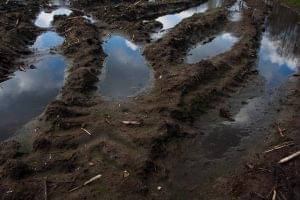Agrometeorology: the Great Plain has inland areas and water shortages at the same time
For a while, the mild, rainy weather that lasted for weeks was favorable for autumn sowing, but in the Great Plains, the seepage cannot keep up with the rainfall on soils with poor water management, so there is water in places at the same time and a significant lack of water in the deeper soil layers – wrote the National Meteorological Service on Thursday in his agrometeorological analysis.

(Photo: Pixabay)
They wrote: in the week behind us, the rainy weather that has lasted for weeks continued, and the weather was several degrees milder than average, in the last ten days, 15-20 millimeters of rain fell in the west, and 25-70 millimeters in other parts. With the exception of the Battonya area, the amount of precipitation for the past 30 days is well above the long-term average, and in large areas it is several times that. The top 20 centimeter layer of the soil across the country, with the exception of the Great Plain, the half-meter layer has already become saturated, but the deeper layers are still dry, especially in the Great Plain, but on soils with poor water management, the seepage is very slow, and precipitation has arrived at a faster rate, so the Great Plain is already inland water. areas have also developed.
On average, the temperature exceeded the long-term average by about 2 degrees Celsius in the last one-week period, maximums between 10 and 15 degrees were typical. The nights were also typically mild, so far in the autumn there have been very few frosty days, and even then the temperature has barely cooled below 0 degrees.
The rainy, mild weather is favorable for autumn sowing, but the heavy rainfall has already stopped on the fields in some places, and the permanent water coverage is not favorable for the herds. In many places, the soil is too muddy for autumn soil work. The canola is well developed, quickly reaching the 6-8 leaf stage, the bushy stands are more and more characteristic of the barley, and the wheat is in the 1-3 leaf stage, and in some places the 3-5 leaf stage, depending on the time of sowing. The effect of the long, mild, rainy autumn is also reflected in the vegetation index showing the “greenness” of the surface, the amount of green mass in large areas is much higher than usual. Due to the few and only weak frosty days, the coloring and falling of the foliage of the natural vegetation occurred well after the usual time, and the grass in the meadows and pastures also turned green.
The changeable, often rainy weather will continue
The weather fronts will follow each other, of which the ones arriving on Friday will bring the most precipitation. By the middle of next week, 5-20 millimeters of precipitation may fall in a large area, so the size of inland areas may increase. The temperature is approaching the usual values for this time. Night frosts will appear from Saturday, but only in the less cloudy and windy parts of the country, i.e. national frost is not likely for the time being. From Saturday, sunshine can be expected in addition to the partly cloudy weather, so far no lasting fog is likely.
MTI
Related news
AM: Government helps farmers with a loan moratorium
🎧 Hallgasd a cikket: Lejátszás Szünet Folytatás Leállítás Nyelv: Auto…
Read more >More than 100 Hungarian farmers also demonstrated in Brussels
🎧 Hallgasd a cikket: Lejátszás Szünet Folytatás Leállítás Nyelv: Auto…
Read more >NAK: Domestic producers await customers with an ample supply of all pine species
🎧 Hallgasd a cikket: Lejátszás Szünet Folytatás Leállítás Nyelv: Auto…
Read more >Related news
NGM: The minimum wage will increase by 11 percent in 2026, and the guaranteed minimum wage by 7 percent
🎧 Hallgasd a cikket: Lejátszás Szünet Folytatás Leállítás Nyelv: Auto…
Read more >The first Hungarian IT teacher would be 110 years old on January 2: Mihály Kovács taught computer science before PCs
🎧 Hallgasd a cikket: Lejátszás Szünet Folytatás Leállítás Nyelv: Auto…
Read more >New Year’s Eve: shortened opening hours in stores – general store closure on January 1
🎧 Hallgasd a cikket: Lejátszás Szünet Folytatás Leállítás Nyelv: Auto…
Read more >






